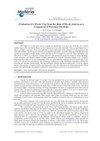Comparative study of diesel sorption performance between Chorisia speciosa fibers and a commercial polyurethane foam
IF 0.5
4区 材料科学
Q4 MATERIALS SCIENCE, MULTIDISCIPLINARY
引用次数: 4
Abstract
The objective of this work was to evaluate and compare the potential of polyurethane and kapok (Chorisia speciosa) residues as sorbent materials in the treatment of diesel spillage. To determine the sorption capacity, gravimetric tests were performed in static medium at room temperature and at different temperatures (10, 15 and 28 °C) and varying the time of contact between the sorbent material and diesel. It was observed that the sorption process occurs at a high velocity, with saturation point achieved in the first 5 minutes of contact, and the natural fiber presents higher sorption capacity compared to the polyurethane residue due to the low viscosity of diesel oil, that contributes to reduce de entrapment inside the porous foam. It has also been observed that the polyurethane residue exhibits an increase in sorption capacity with time and temperature increase. Scanning electron microscopy (SEM) analysis have shown that the main morphological property involved in smooth oil sorption was the high porosity associated with a small porous diameter. The kapok presented sorption capacity of 37 g/g in equilibrium demonstrating its great potential of application as a sorbent material for the treatment of diesel spillage. Keywords: Removal; Diesel; Natural Fiber; Polymer; Sorption.毛藻纤维与商用聚氨酯泡沫吸附柴油性能的比较研究
本研究的目的是评价和比较聚氨酯和木棉(chisia speciosa)残留物作为吸附材料处理柴油泄漏的潜力。为了确定吸附能力,在室温和不同温度(10、15和28°C)下的静态介质中进行了重力测试,并改变了吸附材料与柴油之间的接触时间。结果表明,吸附过程发生在高速下,在接触的前5分钟达到饱和点,并且由于柴油的低粘度,天然纤维比聚氨酯渣具有更高的吸附能力,有助于减少多孔泡沫内部的脱包。还观察到,随着时间和温度的升高,聚氨酯渣的吸附能力也有所增加。扫描电镜(SEM)分析表明,高孔隙率和小孔直径是影响光滑吸油的主要形态特征。木棉在平衡状态下的吸附量为37 g/g,表明木棉作为处理柴油溢出物的吸附剂具有很大的应用潜力。关键词:删除;柴油;天然纤维;聚合物;吸附。
本文章由计算机程序翻译,如有差异,请以英文原文为准。
求助全文
约1分钟内获得全文
求助全文
来源期刊

Materia-rio De Janeiro
MATERIALS SCIENCE, MULTIDISCIPLINARY-
CiteScore
1.00
自引率
25.00%
发文量
51
审稿时长
6 weeks
期刊介绍:
All the articles are submitted to a careful peer-reviewing evaluation process by the journal''s Editorial Board. The Editorial Board, reviewers and authors make use of a web based proprietary automated tool to deal with the reviewing procedures.the Revista Matéria''s article reviewing restricted access system - SEER. Authors are not informed about the identity of the reviewers.
 求助内容:
求助内容: 应助结果提醒方式:
应助结果提醒方式:


